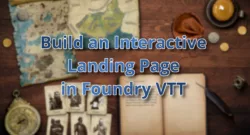Author: MattK
I’ve been involved in TTRPG’s since the 80’s. Perma-DM and Foundry addict.
Community Spotlight #7: Creating Content for Foundry with Blair’s Module Generator!
Blair, the talented coder behind the Scene Packer module, has come out with his latest enhancement: the Foundry VTT Module Generator. Let’s learn more about Blair and his project! You can follow Blair’s work on his Discord as well. FHub: How did you get started with Coding in general, and Foundry in particular? Blair: I’m a self-taught coder having started a little over 20 years ago. I was running a LAN party in Brisbane, Australia with a group of friends (the LAN still runs today, although not so regularly due to Covid restrictions) and we needed a website to be able to host information on when our next LAN was and what to bring (this is back where you didn’t have an internet connection at a LAN party, so you had to bring everything you needed with you). This was my entry into HTML and CSS along with PHP. Over time this eventually led into my overall career, with games being a hobby. I had been playing D&D in person with pen and paper for a few years but then Covid meant that we couldn’t meet up in person anymore, so had to look to online solutions. Eventually I made the switch to Foundry VTT and haven’t looked back. The level of customization and openness really appeals to me, especially with a programming background. FHub: Do you GM or play in any TTRPG games now? If so, which ones? Blair: I GM D&D for a group each fortnight (when there’s enough of us available) in a fairly haphazard way due to the players’ constantly shifting availability. This means that we often stretch out one-shot style adventures and attempt to tie them together in a somewhat meaningful way – this is what lead me to creating the Scene Packer module. I was wanting to move my mini-adventures from my local dev machine onto my Foundry VTT instance to pull them into the world there. An “adventure module” was the way to do it, but my scene journal pins and actor tokens weren’t linked because the IDs changed. Thus, Scene Packer was born. I do get to play as a player every now and then but that’s far less often than when I’m GMing. I do enjoy building out a mini-adventure, trying out all of the various amazing modules that people create within the community and so it’s usually me who has yet-another-adventure ready to go. One of my players is willing to GM an Alien RPG campaign at some point and I am very keen to play that – I’ve been purposefully avoiding reading or looking at any of the content so as to not spoil any of it. FHub: Where do you see the content creation ecosystem for Foundry heading, given that it’s becoming even easier for people to create and package up adventures? Blair: I can see the content ecosystem for Foundry VTT really exploding. With tools like my module generator and Scene Packer making it easier for non-developers to make modules, it’s just a matter of distribution. Currently to distribute your content you need to create a module that the end user installs and activates in their world. This is an easy step to do, but it’s still a required step. A lot of content creators currently release their content via Patreon, so I’m working with the developer of the Moulinette module to integrate Scene Packer. Moulinette is a way for end users to easily search, browse and follow their favorite Patreon creators and install content straight into their Foundry VTT world with no need to install custom modules for each adventure. I’m very excited about the amazing content that already gets built, let alone all of the amazing new content that will continue to be built for Foundry VTT. Understanding Scene-Packer (A Layperson’s Guide) To understand how scene packer works, we must first understand what information is natively stored in a scene in Foundry. Scene data includes walls, lights, ambient sounds, images, fog of war, and drawings. This information follows a scene from world to world without any issues. But there are times when we wish to store additional information in a scene, like actors and journals, as one would find in a ready-to-go adventure. Once actors and journals on a scene are exported out of one world and into another, the links to the underlying data are lost. This is where scene packer comes to the rescue. Scene packer maintains the links in the ‘packed’ scenes to journals and actors in compendiums, allowing for a truly turn-key solution where anyone could create an ‘adventure’ and export it. This is the intent of scene packer in a nutshell. Now, Blair has gone one step further. With his module generator, you can actually create the necessary elements of a full adventure packaged up as a Foundry Module and available to download. A simple solution to a complex series of data packing challenges! Blair’s Guide Creating a Foundry VTT module can be quite daunting, time-consuming, and fiddly. I created a module generator to make it easier to get a module up and running quickly. Depending on your requirements, you may not even have to open a text editor. Visit the generator, fill in the form and download your module zip with all of the values filled in. The generator supports two modes: Scene Packer integrated This mode (listed as “new module” in the generator) creates a new module for you, with Scene Packer module functionality already integrated. This mode is particularly useful for content creators who have an adventure and want to make use of Scene Packer’s functionality, but don’t know any JavaScript or aren’t wanting to fiddle around in a text editor. Standalone Module This mode creates a module without any dependencies. You could use this to quickly create a Shared Compendium Module to share your actors/items/journals between worlds. Alternatively, this mode can be used as a starting point for any custom module you wanted to build. Module generator: https://sneat.github.io/scene-packer-module-generator/ Are you a content creator? Might you become one now that creating adventures is a much easier process? Drop us a line in the comments and let us know your thoughts!
Community Spotlight #6: Cody from Foundry Gaming and Iron Moose Development
Today we talk with Cody (aka CSwendrowski), to hear about his perspective now that he works directly for Foundry Gaming, and take a sneak peek at the direction the team is going with the upcoming Version 9. This article is paired with an AMA (Ask Me Anything) at the Foundry Reddit. Questions for Cody? Find the AMA link *HERE* FHub: We’ll start with the first question on everyone’s minds: What’s it like to work with Atropos and the team? Cody: It’s a pleasure! There were some initial learning curves of working as a team for sure, but the Foundry team is all very talented, and I am glad I can lean on them for their respective spheres of expertise. If there’s a tough community question, Nath has it handled. If a Content creator needs help, I can punt it to Matt, and so on. Atropos is a talented developer who is always showing me new ways to write and organize the code. Foundry is a huge codebase, and even months in I have only delved into a fraction of the systems. Having his guidance into that deep sea has been great. FHub: How did you get started with tabletop RPGs? Do you run any games currently? Cody: My very first TTRPG experience was back towards the end of high school – a friend ran a short-lived campaign of “One Piece D20”. We spent over an hour talking to an NPC about cooking rather than follow any of the plot hooks, which means I got a pretty traditional experience! My class had an Iron Golem companion, which due to bad balancing won the session 2 PCvPCvNPC brawl tournament and earned the Moose-Moose fruit. That companion was the birth of the Iron Moose, a brand that’s stuck with me ever since. These days I run and stream a campaign in the 13th Age system on behalf of the publisher, an offshoot system from the writers behind D&D 3.5e and 4e. I like the system because it strikes a good balance between having rules to form a story framework and not being so heavy as to be clunky. It actively encourages players to be an active part of the story without taking the reins from the GM. My players are currently trying to defeat (or tame!) a giant living dungeon that strikes at cities to form ever growing inner-dungeon-layers, which has been a lot of fun to find and build maps for. You can check out our stream every Monday at 7pm – 9pm CDT at http://twitch.tv/pelgranepress FHub: How did you get into programming? Cody: I started programming when I was 13 years old! I was playing a game called Second Life, which was a sandbox-style game that had its own scripting language based on Lua powering all the user-created objects. Some of these objects had scripts that kindly declared their variables at the top of the file, so young Cody discovered he could adjust some vehicles to have a top speed 100x higher than default. This frequently broke said vehicle, but I was hooked by trying to figure out how to modify things and make them my own. I was lucky enough to have some kind mentors to start me down the track of self-learning, and then was able to take some basic programming classes my Freshman and Sophomore year of high school. I’ve never stopped programming since then. FHub: You have authored quite a few creations of your own over the years. What module or contribution are you most proud of and why? Cody: Clearly 1000 Fish! Joke modules aside, NPC Chatter is probably the one I’m most proud of – not due to the complexity (it’s pretty simple), or it’s ease of use (it’s just a library, no UI), but because of what it brings to the table – a new kind of ambience that fits perfectly alongside Foundry’s ambient sounds. Wandering through a marketplace feels so much more alive when you see NPC’s bartering and hear the sound of footsteps and wind. I’ve been pleasantly surprised to see several creators pick up the module and use it in their creations. One day, I hope to be able to plug it into GPT-3 to autogenerate new unique NPC chatter. FHub: Let’s talk about Version 9. What can you tell us about the direction Foundry development is going and what features are you most excited about? Cody: The big one, of course, is that we’ve changed how we talk about our releases. No longer do we use 0.8.X – we use Version 9. This was an effort I led, and I am glad Atropos trusted me to steer the change of such a pivotal part of the software. There were several technical benefits that Foundry enjoyed as part of this change, and I think developers will be pleased to find they can now declare their modules compatible with all of Version 9, something they couldn’t do under the old versioning. So far, we’ve seen good benefits from the new clarity the versioning brings as well, and I hope that continues. Although plenty of people are excited about Card support, I am personally excited about the potential feature of Keybind Management. Foundry has grown a lot, and so have the number of modules. It would be great to have a centralized place to manage what keyboard shortcuts do what. FHub: Bonus question: Some developers make modules that are lightweight and do just one thing, some make suites that can modify multiple functions in the application. What, in your opinion, makes a module ‘good’, versus ‘not so good’? Cody: I personally try to keep my modules small and modular – in my experience, it makes them easier to manage, and gives users more control over what they include in their games. There’s a lot of value in “feature pack” modules however – you can gain a lot of cool inter-connectivity that is harder to achieve if the modules are separately distributed. It’s very subjective to say what modules are “good” or “bad”, but for my table, I prefer modules that are written such that they don’t leak out and impact other modules. Namespace your CSS rules and you’ll keep me happy! FHub: You also run Iron Moose Development, a prolific module and system design team for Foundry. What’s it like starting and running your own Patreon as a creator for Foundry? Cody: It’s a lot of fun! When I originally write modules, I write them for me and how my table would use them. Releasing them and putting them out to users always blows me away with how many interesting and varied ways people play TTRPG’s. Incorporating those workflows to help them out is fun and rewarding, although I’ve certainly had less time for that than I did before – all of my creative juice goes into Foundry Core these days, which is helping users at a completely different level! I’m a big fan of Open Source, so when I started down the path of trying to make working on Foundry my job (success, although in a different way than I imagined!), I wanted to come up with a monetization setup I felt good about. I arrived at an “early access” program – Alpha users could get the WIP builds and give feedback as I built a feature. Beta users get 2 weeks of early access to a final build, then the release goes live and free to everyone. Once a project starts wrapping up, the whole thing goes Open Source as well. This resonated well with others, and I now work with Asacolips, who provides PBtA and other projects via the same Patreon to give our Patrons a little more bang for the buck. FHub: If you could say one thing to the Foundry community, what would it be? Cody: I enjoy Foundry because I can tailor it for my own personal use. Everyone has their own preferences, and I think that should be encouraged and supported, which is part of why some modules aren’t part of core. Even the most popular module, Dice So Nice, isn’t useful for everyone – some systems don’t use dice! I would encourage everyone to support each other and not get dragged into arguments about the “best” or “right” way to run Foundry or a campaign.
Community Spotlight #5: Level up your game with Beneos Battlemaps and Tokens
For this edition of Community Spotlight, we talk animated maps and tokens with Ben, the creator of Beneos Battlemaps and Beneos Tokens. FHub: How did you get started with tabletop RPGs? Ben: I was always fascinated with role playing games. As a kid I learned pen & paper games which feel like the spiritual parents of traditional RPG computer games like World of Warcraft, where everything that happens is decided by dice rolls. But knowing them and playing them are two different stories. It took me about 30 years to play (or should I say lead?) my first tabletop game. You could call me a noob, but I suffer from a heavy form of hyper-fixation and I consumed so much content (streams, rule systems, etc.), that I would consider myself considerably experience in terms of TTRPGs. Even though I started maybe three years ago I can talk about Pathfinder, Shadowrun, Blades in the Dark, Powered by the Apocalypse games like Dungeon World, as well as about The Dark Eye and Warhammer Fantasy. FHub: You just launched a second Patreon (Beneos Tokens) and obviously have a lot going on. Do you still find time to game? If so, what are you currently playing? Ben: Oh yeah absolutely! It is really important for me to see my content like my Patreons see it during their games. At this moment I run three groups and play in a fourth group as player. All of them in D&D 5E. Two Curse of Strahd groups and two homebrew campaigns. I love it and yeah…I never have enough time. FHub: You are known for creating incredibly rich 3D environments paired with your animated battlemaps. How did you get into 3D modeling? Ben: Early on, I never took 3D modeling or map design very seriously. I started during the early 2000s as a teenager with modding projects. I was part of a team that built a Resident Evil mod for Half Life 2 and the Source Engine. During that time I taught myself sound design, video editing, modeling, texturing and so on. After my modding time I did a lot YouTube stuff. I was pretty successful on YouTube in the early days and I also tried a startup. But in the end, I decided to toss these because I didn’t really warm up to the whole ‘influencer’ industry and the way they look at people. So I worked a more or less normal job as Data Scientist in a telecommunication company. As a DM I invested a lot of time to create cool assets like animated maps. A lot of people asked me to use my content so I was looking for a cheap way to distribute my content and found Patreon. I was fortunate that people really liked what I did. I was successful, and on a side note, I never expected that nor was that the final plan. By the time I noticed people like what I do and are willing to pay it, I decided to try to make it a full time job. FHub: Integrating your maps and scenes with Foundry through modules (and now through Moulinette Cloud) provides a powerful service to the Foundry community. How did you get started with Foundry? Ben: I played for about a year on Roll20 (like many GMs). In a random D&D stream I saw this interesting interface and this unfamiliar tool. I asked around and found out about Foundry. It wasn’t released yet but I really loved and still love the community, so I stuck with it! Yes, I am proud to be a very early adopter of FoundryVTT. FHub: Your battle maps are known for offering a large selection of scenes from Curse of Strahd and you have a catalog of offerings from non-specific fantasy settings and even some sci-fi as well. What direction do you intend to take your creations in the future? Ben: Beneos Battlemaps was always planned as a catalogue of everything a DM would need to create awesome stories and impress their players. So, after closing that chapter I would like to use the sheer endless possibilities of the Unreal Engine to bring stunning sceneries and maps you can’t create without a “Triple-A” engine. But since I have a uniquely realistic and dark-ish style, I also need to create basic maps like taverns, roads, ships and so on. With the power of Unreal Engine, I can promise even those will be next level. FHub: Your animated tokens come pre-packaged with journal entries, stat blocks and multiple views (top-down/Iso) and feature some unique new monsters that will be highly distressing to most adventuring parties. How did you decide to launch your Patreon for animated tokens and where did you come up with these fantastic creatures? Ben: Well frankly I started Beneos Tokens because I could :P. Don’t misunderstand: every time I created a battle map, I always saw all the cool assets I would never be able to use. I have hundreds of high-quality 3D models made by me or commercially licensed via the Unreal Engine Store. They are ready and awesome, so why not use them? I can offer more high-quality content, make some money to reach my goal of being able to make a living out of the best hobby in the whole universe and can use my own tokens in my games. And as a giant bonus I can work with my best friend Leon who creates those super cool stat blocks for every creature with unique abilities and a pretty straightforward design philosophy. He is also a great DM and way more creative than I am. Just another skeleton? I think not. FHub: What’s the future hold for you as a content creator? Where do you see this going? Ben: To be honest I don’t fully know. I listen really carefully to feedback and adapt things I consider valuable. There might be a time where I do something completely different or drop it completely like I did with my YouTube “career”, but this is unlikely because for the first time in my life I really love what I am doing. I’m convinced you can see that in my content as well and the way I treat my Patreons. I will try to push boundaries and prove my content is worth the support, and maybe one day I can make the leap to working 100% on Patreon content! You can check out Ben’s creations at his Battlemaps Patreon and his Tokens Patreon, or hop into his Discord and see what’s coming (Castle Ravenloft anyone?)
Community Spotlight #4: Moulinette is trying to change the game
An Interview with Sven Werlen, aka Dorgendubal, creator of Moulinette. This article is paired with an AMA (Ask Me Anything) at the Foundry Reddit. Questions for Dorgendubal? Find the AMA link *HERE* Moulinette is a series of modules created by Sven Werlen, aka Dorgendubal, a talented programmer from Switzerland who now lives in Montréal, Canada. The modules consist of a core and 5 sub-modules which have different functions. You only need to install the core and then you are free to install whichever modules suit your needs. Moulinette Forge – Scenes: seamlessly import fully built scenes into your world. Share your scenes with the community. Moulinette Forge – Sounds: bring your own sounds and let Moulinette manage them for you (or search from a massive database). Search and play a sound on-the-fly or create a playlist. Create a unique soundboard using icons to represent sounds. Moulinette Forge – Tiles: search tiles and drop them on your maps. Bring your own images and let Moulinette manage them for you. Moulinette Forge – Image search: search images and generate journal entries automatically. Moulinette Forge – Icons: search and import game icons from game-icons.net. There’s a lot here so let’s dive in! First up we hear from Sven and learn how this fantastic suite of modules came about. FHub: What does Moulinette do for Foundry users? SW: Moulinette provides a set of tools to help DMs managing and searching their assets. You can drop all your assets in one or more folders and the module will index them in order to access them in Foundry with user-friendly interfaces. For example, an image can serve as a tile but also as a token (for a character) or even as a journal. On top of that the module also implements a few integrations with external search engines like game-icons.net, the BBC sound effects library or even image search using the Creative Commons search engine or Bing. You are in the middle of a game and a player asks you for a description of the inn? You can within seconds search for images with terms like “rpg medieval inn” and generate a journal that you can share with your players. The Moulinette Sounds module also provides a soundboard which allows a GM to quickly play a selected or randomly chosen sound from a list, as well as decorate the sounds on it with different icons. FHub: There’s a lot of powerful tools here. How (and why) did you develop such an advanced set of modules? SW: I discovered Foundry in April of 2020 and immediately fell in love with its flexibility. As I built my campaign (as a DM), I ran into some repetitive actions that I tried to optimize. I started by developing macros, then modules. Then, a few people from the Francophone community began to appreciate certain elements and to suggest improvements. In summary, initially, it is above all for my games that I developed these modules. And I still use them a lot. FHub: You’re obviously a talented programmer. How did you develop that skillset? SW: I’m not that talented (a good JavaScript developer would certainly have a lot of advice for me 😉 ). What makes me strong is that I am quite versatile. I worked for a long time as a web/backend developer. I have been using Linux for 20 years, which helps me with cloud hosting, pipeline development and automation. But most of what I do is reuse things I find on the internet. FHub:What drove you to create this series of tools? SW: It is very rewarding to see other users enjoying your work. I have a particular motivation because, as a DM, I use my modules every week. But I’m impressed with the amount of great suggestions for improvement coming from users. And I especially love chatting with creators, understanding how they work, and trying to find ways to make it easier for them. If I can save one hour an artist spends “wasting” his time in packaging and publishing his creations, that means that this same artist can spend that hour creating amazing assets. FHub: What’s next for Moulinette? Where do you see the development of this module going? SW: I am now focusing on the cloud part of Moulinette. My goal with this project is to bring creators closer to their users. Moulinette Cloud offers fast hosting capabilities for creators which can save them a lot of time. For example, Moulinette Cloud automatically converts images to webp format or even generates thumbnails for videos. It also offers integration with Patreon to secure your assets. On the other hand, users no longer need to download, update, host and index assets from the content creators they support. As soon as a creator publishes a pack, it becomes immediately available to his supporters (through Moulinette’s interfaces and searches). You don’t even need to reload your page. For more on Moulinette and Moulinette Cloud, head over to Dorgendubal’s Patreon or stop by his Discord and check it out for yourself!
Community Spotlight #3 – Let’s Talk About Maps with Baileywiki!
Our third edition of Community Spotlight highlights Baileywiki, one of our most popular and prolific mapmakers. Baileywiki is known for high quality maps as well as his use of Foundry modules to enhance the features of his work. Check out his Patreon or browse his extensive Youtube playlist for more information! Questions for Baileywiki? This article is paired with the Foundry Reddit, which is hosting an AMA (Ask Me Anything) with Baileywiki *HERE* Let’s talk with Baileywiki and see what we can learn! FHub: How did you get started with Roleplaying Games? What is/are your favorite RPG(s)? BW: I am the father of 3 boys, and screens were taking over their lives. I wanted something that we could do together that let us interact and play in more creative ways. I was listening to Critical Role at the time and was thinking back to my childhood and the great memories (and skills) I developed through D&D. So we started an epic 2 year game and they loved it. The problem was that I couldn’t find maps that I was happy with. So I discovered Dungeondraft, and then Forgotten Adventures, and then I started to post maps to Reddit that would get 1,000 upvotes. Various someones suggested I do a Patreon, which sounded absurd at the time, but interesting. Fast-forward to today, and I’ve got a thriving Patreon and a valued community of fellow nerds and techno-artists around me. I love it. I’m focused on the fantasy space at the moment. But if you follow my work, I really push the boundaries of technology and art. I make Dungeondraft and Foundry and even the core artwork do things that no one has seen before. I like combining macros with modules and interesting visual art to create spaces that will make players gasp and squeal with excitement. I know the feeling when, as a DM, I do something that really impresses my players. It’s sad how much we live for that moment. But it’s infinitely satisfying. FHub: What is your history with TTRPGs? Do you play currently? BW: I learned the game as a kid at 10 years old, then took 30 years off. Now I DM for my boys and their cousins and friends. I’d love to play in a game myself, but someone will have to invent a time machine for that to happen now. Note: As of publication, the Foundry Hub staff is not aware of any working time machines ~ Ed. I’m an inventor before I’m an artist. — Baileywiki FHub: For those folks who like to create their own maps, what map-making software do you recommend? BW: I strongly recommend Dungeondraft. Is it the best graphics editing software? Not even close. But it’s accessible. The user experience is as simple as it gets, and with the ability to change the artwork to something like Forgotten Adventures or Tom Cartos, it means ANYONE can be a decent map maker in a very short amount of time. It’s why I stay with Dungeondraft. The idea of simplicity is far more powerful than the raw power of the program itself. My Discord and Patreon are full of amazing artists that just started 2 months ago by watching my videos. I see my design influence all over the Reddit and Roll20 communities, and I couldn’t be happier. I’ve also helped bring attention to Foundry, Dungeondraft, and the artists that I find exceptional along the way, like Forgotten Adventures and Tom Cartos. That’s also rewarding to me. FHub: How did you get started with modifying your maps with Foundry functionality? BW: I discovered Foundry after Roll20 sent me screaming. Talk about bad design and no simplicity. Foundry was awesome by comparison. But then I discovered the open nature of Foundry and the module developers and technology community around it, and I was sold Unlike most professional map makers who are generally artists by trade, I don’t consider myself an artist. I’m as comfortable with tech as I am with color palettes. Being able to bring a beautiful map into a platform that can instantly teleport my players to new levels, or two or three modules that, working together, can create never-before-seen game mechanics…that stuff tickles me. I’m an inventor before I’m an artist. FHub: You make a lot of detailed videos explaining how to use your maps in Foundry. How much time does it take to build a map set with Foundry modifications and tutorial videos? BW: If I spend an hour making a map, I’ll spend another hour making it “Foundry ready”, and then another hour making a video on the process. The fact is, most of my maps take more like three to five hours, so it’s a VERY big process to produce at my cadence (every 2 weeks). I tend to include a lot more detail and technology in my maps than others, so I’m doing it to myself at the end of the day. But hey, it’s why people sub to me. If you’ve ever made these things yourself, it’s a full-time job and they appreciate the time that they didn’t have to spend. FHub: Of all your map packs, what are your favorites? BW: My favorite single map is the Galleon. It put me on the map (pun intended), and I still enjoy playing it. But my favorite work so far is The Town. It’s an entire town, modeled loosely after Phandalin, but built entirely with modular parts. It’s the culmination of the modular town, wilderness and dungeon systems that I’ve been developing for the last few months, and it demonstrates the power of all of this art and science cobbled together in a way that lets DMs build anything they want, instead of map makers or anyone else limiting their imagination or storytelling. FHub: What’s next for Baileywiki Maps? BW: I’m just getting started. I’ve taken on my first staff member, Zephyr, and not only are we planning some huge releases around the modular system and large-scale premium maps, but we’re also doing licensing deals with artists, working on technology with developers and the League, and also bringing my community into contributing their own art and innovation back into the ecosystem, like with the modular dungeon system. As you’ll hear often on my Discord, “Ideas are the coin of the realm.” New ideas and pushing boundaries are what you’ll keep seeing from the Baileywiki tribe. For more information from Baileywiki on his work, you can visit his Discord. For access to his advanced maps for Foundry (and much more), you can support him via his Patreon. Big shout out to Baileywiki for making the time to talk with us!
Community Spotlight #2 – KaKaRoTo
An interview with KaKaRoTo, creator of The Forge, a Foundry hosting service, as well as many of Foundry's most popular modules.
Foundry Tips and Tricks – Let’s Build a Landing Page!
Let's learn how to do some cool stuff in Foundry! Let's make a landing page. Note: This is not an exhaustive step-by-step walkthrough. It should get you pointed in the right direction though.
Community Spotlight #1 – We Talk Isometric Play with Grape_Juice
Today we sit down for a chat with Grape_Juice, the creator of Grape Juice Isometrics module. He is also responsible for other useful modules like MiniMap and Fantasy Grounds Converter, as well as the soon-to-be released Material Dice and Random Dungeon Generator modules for Foundry VTT. Stop by his Discord, Github or check out his Patreon for more information!
- 1
- 2










